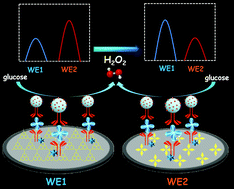H2O2-activated independently bidirectional regulation for a sensitive and accurate electrochemiluminescence ratiometric analysis†
Abstract
Potential-resolved electrochemiluminescence (ECL) ratiometric analysis has become a research hotspot in bioassays by virtue of its good accuracy, versatility and specificity. Current ECL ratiometry mainly focuses on the competition for the co-reactant or quantitative analysis using a variable signal and a changeless signal; the disorganized change or small difference between the two signals may affect the accuracy and sensitivity of detection. In this study, we have developed a novel ECL ratiometric sensor based on the bidirectional regulation of two independent co-reaction systems by H2O2. H2O2 as a bidirectional moderator permits the ECL signals of the cathode and anode to independently change in opposite trends, which greatly enhances the organization and difference between the two signals. The ratio of the two signals is used to realize the quantitative analysis of myoglobin (MyO) with a good linear relationship between log(ECLcathode/ECLanode) and log CMyO in the range of 1.0 × 10−13 to 1.0 × 10−7 g mL−1. The detection limit is 4.0 × 10−14 g mL−1. Furthermore, it showed excellent performance in the determination of MyO in human serum samples. The proposed biosensor provides some developments for the sensitive and accurate detection of disease markers.



 Please wait while we load your content...
Please wait while we load your content...